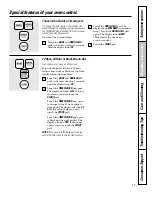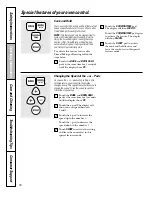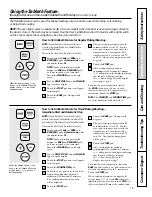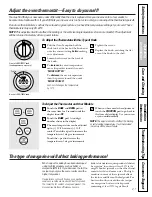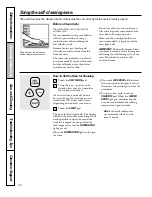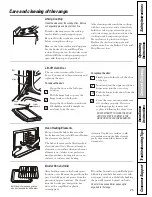
24
Operating
Instructions
Safety Instructions
Care and Cleaning
Installation
Instructions
Tr
oubleshooting T
ips
Consumer Support
With proper care, the porcelain enamel
finish on the inside of the oven---top,
bottom, sides, back and inside of the door---
will stay new-looking for years.
Let the range cool before cleaning. We
recommend that you wear rubber gloves
when cleaning the range.
Soap and water will normally do the job.
Heavy spattering or spillovers may require
cleaning with a mild abrasive cleaner.
Soap-filled scouring pads may also be used.
Do not allow food spills with a high
sugar or acid content (such as milk,
tomatoes, sauerkraut, fruit juices or
pie filling) to remain on the surface. They may
cause a dull spot even after cleaning.
Household ammonia may make the
cleaning job easier. Place 1/2 cup in a
shallow glass or pottery container in a cold
oven overnight. The ammonia fumes will
help loosen the burned-on grease and food.
If necessary, you may use an oven cleaner.
Follow the package directions.
Do not spray oven cleaner on the electrical controls
and switches because it could cause a short circuit
and result in sparking or fire.
Do not allow a film from the cleaner to build up on
the temperature sensor–it could cause the oven to
heat improperly. (The sensor is located at the top of
the oven.) Carefully wipe the sensor clean after each
oven cleaning, being careful not to move the sensor
as a change in its position could affect how the
oven bakes.
Do not spray any oven cleaner on the oven door,
handles or any exterior surface of the oven, cabinets
or painted surfaces. The cleaner can damage these
surfaces.
Oven Interior
(non-self clean models)
If your range is removed for cleaning,
servicing or any reason, be sure the
anti-tip device is re-engaged properly
when the range is replaced. Failure
to take this precaution could result in
tipping of the range and cause injury.
Be sure electrical power is off and all surfaces are cool before cleaning any part of the range.
Care and cleaning of the range.
The porcelain enamel finish is sturdy
but breakable if misused. This finish is
acid-resistant. However, any acidic foods
spilled (such as fruit juices, tomato or
vinegar) should not be permitted to remain
on the finish.
If acids spill on the cooktop while it is hot,
use a dry paper towel or cloth to wipe it up
right away. When the surface has cooled,
wash with soap and water. Rinse well.
For other spills such as fat spatterings, wash
with soap and water or cleansing powders
after the surface has cooled. Rinse well.
Polish with a dry cloth.
Porcelain Enamel Cooktop
(on some models)
The gasket is designed with a gap
at the bottom to allow for proper
air circulation.
Because the area inside the gasket is
cleaned during the self-clean cycle,
you do not need to clean this by hand
on self-clean models.
The area outside the gasket and the
front frame can be cleaned with a
soap-filled steel-wool pad, hot water
and detergent. Rinse well with a
vinegar and water solution.
Do not rub or clean the door
gasket–it has an extremely low
resistance to abrasion.
If you notice the gasket becoming
worn, frayed or damaged in any way,
or if it has become displaced on the
door, you should have it replaced.
To clean the inside of the door:
Do not allow excess water to run into any
holes or slots in the door.
Soap and water will normally do the job.
Heavy spattering or spillovers may require
cleaning with a mild abrasive cleaner.
Soap-filled, steel-wool pads may also
be used.
Do not allow food spills with a high sugar or acid
content (such as milk, tomatoes, sauerkraut, fruit
juices or pie filling) to remain on the surface. They
may cause a dull spot even after cleaning.
To clean the outside of the door:
Use soap and water to thoroughly clean
the top, sides and front of the oven door.
Rinse well. You may also use a glass
cleaner to clean the glass on the outside
of the door. Do not let water drip into the
vent openings.
Spillage of marinades, fruit juices, tomato
sauces and basting materials containing
acids may cause discoloration and should
be wiped up immediately. When surface
is cool, clean and rinse.
Do not use oven cleaners, cleaning
powders or harsh abrasives on the
outside of the door.
To clean outside of the gasket:








